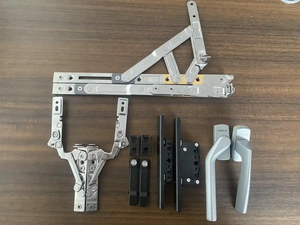
Requirements and methods for inspecting building door and window hardware - Factory inspection and quality inspection services
As the core component of the building door and window system, the quality of hardware directly affects the safety performance and user experience of the building. To ensure that the building door and window hardware meets national standards and quality certification requirements, establishing a professional inspection process is of vital importance. This article will systematically introduce the inspection standards, testing methods and certification requirements for door and window hardware, providing a complete quality control guide for enterprises.
I. Product Classification Inspection and Certification System
1.1 Inspection and Certification of Operating Components
Control handle for transmission mechanism: Dual certification of material and function
Rotational press handle: Special inspection and certification for operational performance
Double-sided handles: Symmetry and durability inspection assessment
Single-point Locking Device: Professionally Certified for Safety Performance
Pull handle and window opener: Ergonomics and reliability inspection tests
1.2 Quality Certification of Supporting Components
Hinges (Hinges): Load-bearing Capacity Inspection Certification
Door Clamping: Standardized Test for Clamping Force
Sliding test: Special test for sliding performance
Horizontal sliding window support: Professional certification of parallelism
Sprocket: Rolling Resistance Inspection and Evaluation
Gravity spring: Reset accuracy certification test
1.3 Inspection and Certification of Transmission Locking Components
Transmission Locking Mechanism: Professional Inspection for Synchronization
Multi-point Locking Device: Coordinated Standardized Certification
Plug: Positioning accuracy inspection test
1.4 Auxiliary Component Function Certification
Support and Guard: Positioning Stability Inspection Certification
Lifting device: Professional test of lifting force
Anti-detachment Device: Special Inspection for Safety Performance
Fall prevention device: Evaluation of protective capability certification
Temperature control window closing device: Performance verification test for response capability
II. Material Selection and Inspection Certification Standards
2.1 Compliance Certification of Main Materials
Die-cast zinc alloy: Component and density inspection for verification
Stainless Steel: Professional Certification for Rust Prevention Performance
Aluminum alloy: Strength and Durability Inspection Test
Carbon steel: Surface treatment quality certification
Copper alloy: Special inspection for corrosion resistance performance
2.2 Material Ratio Inspection Requirements
The materials of each component must comply with the recommended standard certification.
Inspection and Evaluation of Special Properties of Non-standard Materials
Material Compatibility Professional Testing Certification
III. Appearance Quality Inspection and Certification System
3.1 Surface Quality Inspection Certification
Exposure surface defect inspection standards: No scratches, pores, or depressions
Professional certification of connection strength: Smooth and round without cracks
Strict inspection standards for sharp edges and sharp points
3.2 Inspection and Certification of Coating Quality
Standardized inspection of color uniformity
Professional certification for coating integrity: No bubbles, no run-off, no peeling
Strict control measures have been implemented for the phenomenon of stacking citrus peels.
3.3 Layer Performance Inspection and Certification
Professional Inspection of Layer Density
Uniformity standardization certification
Leakage and yellowing issues are rigorously inspected.
3.4 Anodic Oxidation Surface Certification
Oxide Film Density Inspection
Professional assessment of color consistency
Standardized test for uniformity of film thickness
IV. Performance Indicator Inspection and Certification Standards
4.1 Film Thickness and Adhesion Certification
Standardized measurement of film thickness
Adhesion professional testing and certification
Durability inspection assessment
4.2 Corrosion Resistance Performance Certification
Standardized Salt Spray Test Inspection
Professional assessment of corrosion grade
Durability performance certification test
4.3 Weather Resistance Performance Inspection Certification
Standardization of Artificial Aging Test
Professional measurement of gloss variation
Color difference variation inspection and evaluation
4.4 Moisture and Heat Resistance Performance Certification
Constant temperature and humidity environment inspection test
Professional inspection of rusting and blistering phenomena
Standardized certification of durability performance
V. Function and Performance Inspection and Certification System
5.1 Opening and Closing Operation Performance Certification
Standardized inspection measurement of operating force
Torque balance professional test
Smoothness Special Certification
5.2 Repeated Opening and Closing Performance Certification
Standardized Inspection for Durability Test Cycle
Professional assessment of performance stability
Wear degree certification test
5.3 Safety Device Performance Certification
Inspection standards for fall prevention devices:
3000N static load professional test
Dynamic Impact Safety Certification
Component integrity inspection and evaluation
Thermal control window closing device certification:
Test of response performance of thermal sensitive elements
Standardized inspection with windows closed
Professional Certification in Functional Reliability
VI. Inspection Certification Process Standards
6.1 Inspection Environment Certification
Standardization of natural light or 300-600 lx illumination intensity
400 - 500mm visual measurement distance professional requirements
Standardized management of inspection conditions
6.2 Method Certification for Testing
Film thickness measurement: Certified in accordance with the GB/T standards.
Adhesion test: Standardized inspection process
Corrosion resistance test: Strictly carried out in accordance with national standards.
6.3 Sampling Inspection Plan
Implement statistical sampling certification in accordance with industry standards
Key safety project comprehensive inspection and certification system
Establishment of a complete quality traceability system
VII. Key Control Matters for Factory Audit
To ensure that the quality of door and window hardware components consistently meets the certification requirements, during the factory audit process, the following key points need to be focused on:
Production process control certification: Establishing operation specifications for key processes
Material Management Certification: Implementing a Supplier Quality Assessment System
Calibration of testing equipment: Regularly calibrate measurement instruments and equipment
Quality management system: Certified by ISO9001 quality system standard
Personnel qualification certification: Inspection personnel undergo professional training and obtain certificates before taking up their positions.
Inspection and Certification Summary
The inspection and certification of building door and window hardware components is a highly technical and rigorous systematic process that requires comprehensive inspection and certification of materials quality, processing techniques, and functional performance. By establishing a professional inspection process and strict quality standards, enterprises can ensure that the hardware products meet industry certification requirements, providing safe and reliable door and window system solutions for construction projects.
Share this product

Requirements and methods for inspecting building door and window hardw
The core components of the building door and window system, the quality of the hardware directly affects the safety performance of the building.
